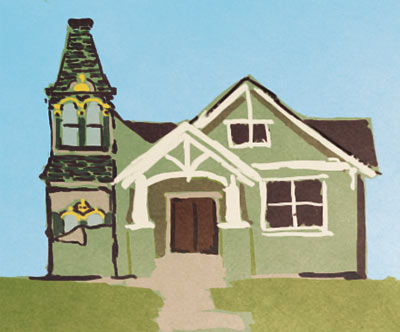COMMENT OF THE DAY: HOUSTON HEIGHTS HISTORY IN THE MAKING  “. . . They probably looked around and saw hundreds of 3k-plus-sq.-ft. Faux Craftsman, Faux Victorian, Faux Colonial, Faux Historic, etc. ‘bungalows,’ that have replaced (or bastardized) most of the real Craftsman, Victorian, Colonial, historic bungalows and realized that the Heights ‘style’ is all fake anyway, so why bother replicating more Faux? They instead designed a building that represents its own era, 2016. . . . Don’t fret, in 100 years, this will be ‘historic’ too.” [John M, commenting on Once Bashful Heights Post Office Replacement Retail Now Willing To Step Up to the Street, Learn To Like Sidewalks] Illustration: Lulu
“. . . They probably looked around and saw hundreds of 3k-plus-sq.-ft. Faux Craftsman, Faux Victorian, Faux Colonial, Faux Historic, etc. ‘bungalows,’ that have replaced (or bastardized) most of the real Craftsman, Victorian, Colonial, historic bungalows and realized that the Heights ‘style’ is all fake anyway, so why bother replicating more Faux? They instead designed a building that represents its own era, 2016. . . . Don’t fret, in 100 years, this will be ‘historic’ too.” [John M, commenting on Once Bashful Heights Post Office Replacement Retail Now Willing To Step Up to the Street, Learn To Like Sidewalks] Illustration: Lulu





The grapes are sour with this one…
I agree with the comment (John M). It is lost on people that history is a bowling ball, not a bowling pin. Things churn over repeatedly, smashing the past and setting new precedents for the future. Much later, we selectively decide which attributes were greatest in the lost era or neighborhood, and forget all those pesky details that plagued the area (like racism, puritanical alcohol laws, and oh yeah – and child-raping serial killers). This is the problem with “preservation” in an area like the Heights. People today have an idea of how the Heights might have looked once, and they want a semblance of that look, so they focus on decorative architecture. The problem is that the “look” is only superficial, like a mask covering someone’s real face. These old-looking new structures are 3x the size of most original homes in the area. They have PEX plumbing, 3+ bathrooms, insulation, HVAC systems, 2 car garages, Hardi plank siding, etc. These buildings are NOTHING like the old structures, other than a faux façade that attempts to replicate an architectural style, that itself attempted to replicate an architectural style (the “neo” styles of the 1880’s).
It has no chance of being historic. This look will be garishly out of fashion in 20 years. At that point, someone will remove the entire facade and put up some faux-historic adornments that are trendy at the time.
The comment mistakes historic preservation for curating a museum. No one has ever sought to use historic preservation laws to keep a community frozen in time. Historic preservation is about balancing the modern needs of a community with the desire to preserve the character of a historically and architecturally significant area. It has not been a perfect process in the Heights mainly because it took so long to get a historic ordinance in place that a lot of damage had already been done. But the difference between development inside the historic districts and outside is night and day. Norhill is very well preserved thanks to also having deed restrictions. but the southwest quadrant of the Heights proper is an almost unrecognizable mish mash of town homes, faux this that and the other thing and the odd surviving bungalow. This development is not perfect, but just look down the street at the seven story “condo” building Terry Fisher is cramming into Yale St. to see just how significant historic preservation efforts really are.
As long as historic preservation is geared towards preventing density, it has no place in a modern city.
I see both points of view on the historic vs. not Heights. I’m with superdave on the huge new homes looking completely out of place and the old deed restrictions serving to retain the neighborhood character in Norhill. As you ride around the Heights it’s easy to guess what decade the new builds are from and as mentioned above many have not aged well. It will be interesting to see how blocks that passed the minimum lot size requirements look over time. I view minimum lot size as the best way to preserve the neighborhood. Yale is a good street for increased density but I feel for the homeowners who won’t see the sun until noon but that didn’t slow down the sales for the small lot homes across from the Alexan on Allston.